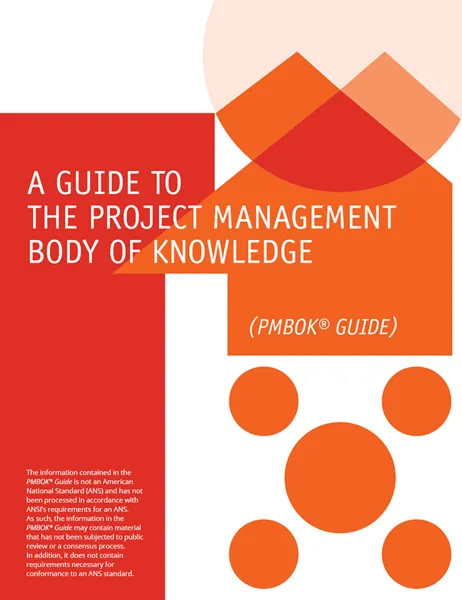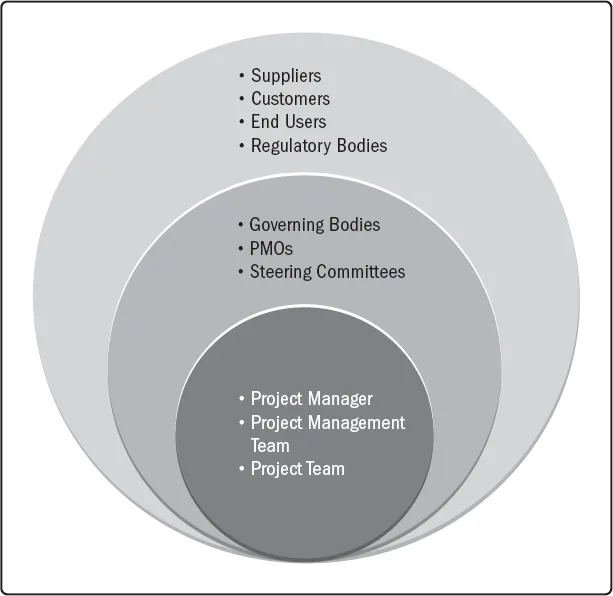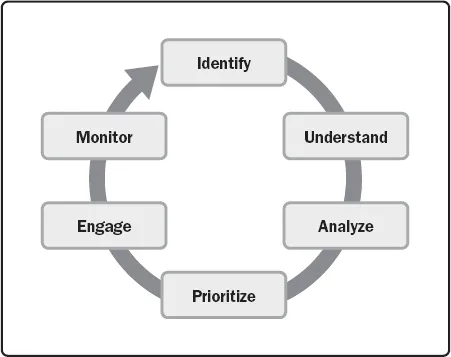
eBook - ePub
A Guide to the Project Management Body of Knowledge (PMBOK® Guide) – Seventh Edition and The Standard for Project Management (ENGLISH)
This is a test
Compartir libro
- 368 páginas
- English
- ePUB (apto para móviles)
- Disponible en iOS y Android
eBook - ePub
A Guide to the Project Management Body of Knowledge (PMBOK® Guide) – Seventh Edition and The Standard for Project Management (ENGLISH)
Detalles del libro
Vista previa del libro
Índice
Citas
Información del libro
PMBOK® Guide is the go-to resource for project management practitioners. The project management profession has significantly evolved due to emerging technology, new approaches and rapid market changes. Reflecting this evolution, The Standard for Project Management enumerates 12 principles of project management and the PMBOK® Guide – Seventh Edition is structured around eight project performance domains.
This edition is designed to address practitioners' current and future needs and to help them be more proactive, innovative and nimble in enabling desired project outcomes.
This edition of the PMBOK® Guide:
- Reflects the full range of development approaches (predictive, adaptive, hybrid, etc.);
- Provides an entire section devoted to tailoring the development approach and processes;
- Includes an expanded list of models, methods, and artifacts;
- Focuses on not just delivering project outputs but also enabling outcomes; and
- Integrates with PMIstandards+™ for information and standards application content based on project type, development approach, and industry sector.
Preguntas frecuentes
¿Cómo cancelo mi suscripción?
¿Cómo descargo los libros?
Por el momento, todos nuestros libros ePub adaptables a dispositivos móviles se pueden descargar a través de la aplicación. La mayor parte de nuestros PDF también se puede descargar y ya estamos trabajando para que el resto también sea descargable. Obtén más información aquí.
¿En qué se diferencian los planes de precios?
Ambos planes te permiten acceder por completo a la biblioteca y a todas las funciones de Perlego. Las únicas diferencias son el precio y el período de suscripción: con el plan anual ahorrarás en torno a un 30 % en comparación con 12 meses de un plan mensual.
¿Qué es Perlego?
Somos un servicio de suscripción de libros de texto en línea que te permite acceder a toda una biblioteca en línea por menos de lo que cuesta un libro al mes. Con más de un millón de libros sobre más de 1000 categorías, ¡tenemos todo lo que necesitas! Obtén más información aquí.
¿Perlego ofrece la función de texto a voz?
Busca el símbolo de lectura en voz alta en tu próximo libro para ver si puedes escucharlo. La herramienta de lectura en voz alta lee el texto en voz alta por ti, resaltando el texto a medida que se lee. Puedes pausarla, acelerarla y ralentizarla. Obtén más información aquí.
¿Es A Guide to the Project Management Body of Knowledge (PMBOK® Guide) – Seventh Edition and The Standard for Project Management (ENGLISH) un PDF/ePUB en línea?
Sí, puedes acceder a A Guide to the Project Management Body of Knowledge (PMBOK® Guide) – Seventh Edition and The Standard for Project Management (ENGLISH) de en formato PDF o ePUB, así como a otros libros populares de Business y Project Management. Tenemos más de un millón de libros disponibles en nuestro catálogo para que explores.
Información

1 |
Introduction
This section describes important information about A Guide to the Project Management Body of Knowledge (PMBOK® Guide) – Seventh Edition. It describes the relationship of the PMBOK® Guide to The Standard for Project Management [1],1 changes to the PMBOK® Guide, the relationship to PMIstandards+™ (PMI's digital platform for standards), and provides a brief overview of the content.
1.1 STRUCTURE OF THE PMBOK® GUIDE
In addition to this Introduction, this edition of the PMBOK® Guide contains three sections:
- Section 2 Project Performance Domains. This section identifies and describes eight project performance domains that form an integrated system to enable successful delivery of the project and intended outcomes.
- Section 3 Tailoring. This section describes what tailoring is and presents an overview of what to tailor and how to go about tailoring individual projects.
- Section 4 Models, Methods, and Artifacts. This section presents a brief description of commonly used models, methods, and artifacts. These models, methods, and artifacts illustrate the range of options project teams can use to produce deliverables, organize work, and enable communication and collaboration.
1.2 RELATIONSHIP OF THE PMBOK® GUIDE AND THE STANDARD FOR PROJECT MANAGEMENT
Work in the project performance domains is guided by the principles of project management. As described in The Standard for Project Management [1], a principle is a fundamental norm, truth, or value. The principles for project management provide guidance for the behavior of people involved in projects as they influence and shape the performance domains to produce the intended outcomes. While there is conceptual overlap between the principles and the performance domains, the principles guide behavior, while the performance domains present broad areas of focus in which to demonstrate that behavior. Figure 1-1 shows how the project management principles sit above the performance domains, providing guidance to activities in each performance domain.

Figure 1-1. Relationship between Project Management Principles and Project Performance Domains
1.3 CHANGES TO THE PMBOK® GUIDE
This edition of the PMBOK® Guide focuses on delivering outcomes regardless of the approach used by the project team. However, project practitioners using the PMBOK® Guide also benefit from some level of understanding of how to deliver projects.
This edition is very different from the inputs, tools/techniques, and outputs (ITTOs) from previous editions of the PMBOK® Guide. In the previous editions, the ITTOs supported implementation of various processes used in project management. The shift from a process-based standard to one based on principles necessitates a different approach for thinking about the various aspects of project management. Thus, the project performance domains represent a group of related activities that are critical for the effective delivery of project outcomes. There are eight project performance domains in this guide.
Tailoring is the deliberate adaptation of the project management approach, governance, and processes to make them more suitable for the given environment and the work at hand. The tailoring process is driven by the guiding project management principles, organizational values, and organizational culture.
In embracing the full spectrum of project approaches, this edition of the PMBOK® Guide recognizes that no publication can capture every tool, technique, or practice that project teams might use. Therefore, this edition presents an array of commonly used models, methods, and artifacts that project practitioners can use to accomplish their work.
1.4 RELATIONSHIP TO PMIstandards+
Information in this guide is further elaborated on PMIstandards+, PMI's digital content platform. The digital platform encompasses current and emerging practices and other useful information related to PMI's library of standards products. It also includes practical examples of application within various contexts and industry segments. PMIstandards+ evolved in response to advances and changes in how projects can be delivered. It offers a dynamic body of knowledge with real-time access and in-depth information that is aligned to PMI standards and carefully vetted by a panel of subject matter experts representing a wide range of expertise.
1 The numbers in brackets refer to the list of references at the end of the PMBOK® Guide.
2 |
Project Performance Domains
A project performance domain is a group of related activities that are critical for the effective delivery of project outcomes. Project performance domains are interactive, interrelated, and interdependent areas of focus that work in unison to achieve desired project outcomes. There are eight project performance domains:
- Stakeholders,
- Team,
- Development Approach and Life Cycle,
- Planning,
- Project Work,
- Delivery,
- Measurement, and
- Uncertainty.
Together the performance domains form a unified whole. In this way, the performance domains operate as an integrated system, with each performance domain being interdependent of the other performance domains to enable successful delivery of the project and its intended outcomes.
Performance domains run concurrently throughout the project, regardless of how value is delivered (frequently, periodically, or at the end of the project). For example, project leads spend time focused on stakeholders, the project team, the project life cycle, the project work, and so forth, from the outset of the project to its closure. These areas of focus are not addressed as siloed efforts because they overlap and interconnect. The ways in which the performance domains relate are different for each project, but they are present in every project.
The specific activities undertaken within each of the performance domains are determined by the context of the organization, the project, deliverables, the project team, stakeholders, and other factors. The performance domains are presented in the following sections without specific weighting or order.
2.1 STAKEHOLDER PERFORMANCE DOMAIN

Figure 2-1. Stakeholder Performance Domain
Projects are performed by people and for people. This performance domain entails working with stakeholders to maintain alignment and engaging with them to foster positive relationships and satisfaction.
Stakeholders include individuals, groups, and organizations (see Figure 2-2). A project can have a small group of stakeholders or potentially millions of stakeholders. There may be different stakeholders in different phases of the project, and the influence, power, or interests of stakeholders may change as the project unfolds.

Figure 2-2. Examples of Project Stakeholders
Effective stakeholder identification, analysis, and engagement includes stakeholders who are internal and external to the organization, those who are supportive of the project, and those who may not be supportive or are neutral. While having relevant technical project management skills is an important aspect of successful projects, having the interpersonal and leadership skills to work effectively with stakeholders is just as important, if not more so.
2.1.1 STAKEHOLDER ENGAGEMENT
Stakeholder engagement includes implementing strategies and actions to promote productive involvement of stakeholders. Stakeholder engagement activities start before or when the project starts and continue throughout the project.

Figure 2-3. Navigating Effective Stakeholder Engagement
Defining and sharing a clear vision at the start of the project can enable good relationships and alignment throughout the project. Establishing a clear vision that key stakeholders agree on can entail some challenging negotiations, especially with stakeholders who are not necessarily in favor of the project or its intended outcomes. As shown in Figure 2-3, there are several steps to engage stakeholders effectively.
2.1.1.1 Identify
High-level stakeholder identification may be carried out prior to forming the project team. Detailed stakeholder identification progressively elaborates the initial work and is a continuous activity throughout the project. Some stakeholders are easy to identify, such as the customer, sponsor, project team, end users, and so forth, but others can be difficult to identify when they are not directly connected to the project.
2.1.1.2 Understand and Analyze
Once stakeholders are identified, the project manager and the project team should seek to understand stakeholders’ feelings, emotions, beliefs, and values. These elements can lead to addi...